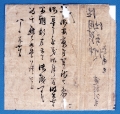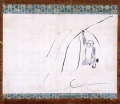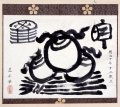| Title | |||
|---|---|---|---|

|
A Pair of Wooden Shrine Guardian Dogs | ||
| This is a pair of wooden shrine guardian dogs placed at the worship hall of Kosho Hachiman Shrine. The sculptor is unknown. They are thought to have been made at the end of the 16th century. |
|||

|
Cultural Properties at Kosho Hachiman Shrine | ||
| Kosho Hachiman Shrine houses documents that explain the process of giving Hachiman Shrine at Kanaya Palace to Tokumoto Village in 1871, historical documents related to Hachiman Shrine, and document... |
|||

|
Former Site of Go Elementary School | ||
| Go Elementary School was built in Tanaka Village in 1876. After the Pacific War in 1947, a junior high school was attached to the elementary school. In 1951, the junior high school was moved t... |
|||

|
Former Site of Taheiji Temple | ||
| The name, Taheiji, is from Taheiji Temple established in the area by Gen-I Fushaku, a senior disciple of Sotetsu Meiho, the 4th chief priest of Daijoji Temple. Historical materials housed at ... |
|||

|
Former Site of the Gorobe Takatsuka Residence | ||
| Futsukaichi is home to a legend about a white fox and Gorobe, a vassal serving Masachika Togashi. The legend tells of a white fox in Nonoichi. This fox often cheated people, so Masachika asked... |
|||

|
Former Site of the Zenshiro Mitsubayashi Residence | ||
| In Shimobayashi there is an area named Shirozuka that comes from the "Shiro" in Zenshiro Mitsubayashi. Zenshiro Mitsubayashi was a leader of the Jodo-shinshu Sect, and fought in the Ikko Ikki... |
|||

|
Futsukaichi | ||
| The name, Futsukaichi (Market on dates with the number 2 in them), came from a market held on the 2nd, 12th, and 22nd of each month around the 14th century. It was located near Yokoe-no-sho, a mano... |
|||

|
Futsukaichi Ishibachi Sites | ||
| Discoveries at the Futsukaichi Ishibachi Sites include settlements dating from the Yayoi (500BC - AD300), Tumulus (late 3rd century - 7th century), and Middle Ages, and ancient mounds from the Tumu... |
|||

|
Futsukaichi Mura Muragoin | ||
| This is the Futsukaichi Mura Muragoin (the Futsukaichi Village Land Tax Notification) issued in 1670. It lists the details of taxation. It lists 548 koku (kusadaka: total rice production), and a 45... |
|||

|
Gikai Tettsu Final Resting Place | ||
| This is the final resting place of Daijoji Temple founder Gikai Tettsu. Measuring 67cm high, 33cm wide, and 24cm thick, this natural stone is inscribed with the words, "Daijoji Temple Founding Prie... |
|||

|
Go (Former Shimo-tanaka) | ||
| Go Town was formerly named Tanaka Village. The name Tanaka first appeared in a document dated 1622 that was housed at Higashi Honganji Temple. Tanaka Village consisted of two areas, Kami-tanaka and... |
|||

|
Go Jonkara (Go dance) | ||
| Go jonkara was created in 1947 when people in the village danced at Go Elementary School. Women wore a red sash and a wraparound slip and men wore a kentai, or red sash and head band when dan... |
|||

|
Hachiman Okami no Shingogaku | ||
| The framed name of the Hachiman God was displayed at Hachiman Shrine at Kanaya Palace. On the back of the frame, there is the engraved description of being written by Nariyasu Maeda in 1870. On the... |
|||

|
Hachiman Okami no Shingojiku | ||
| The framed name of the Hachiman God was displayed at Hachiman Shrine at Kanaya Palace. On the back of the frame, there is the engraved description of being written by Nariyasu Maeda in 1870. On the... |
|||

|
Historical Monument of Nonoichi Station | ||
| After the Pacific War, Hokuriku Line (railway) became electric. In 1957, people started a movement to build a train station in Nonoichi. In 1959, town associations in Nonoichi got together and subm... |
|||

|
Horiuchi | ||
| The area name, Horiuchi, appeared in the Tenbun Nikki (Tenbun Diary) written by Shonyo, the 10th chief abbot of the Honganji Temple, in the 16th century. Landholders' residences were often surround... |
|||

|
Inari | ||
| The area's name, Inari, is found in the 1491 diary of Court Noble Tamehiro Reizei as Inari Shrine. It has also been noted that abandoned land in this area was cultivated and developed into Inari Vi... |
|||

|
Kame no Ji | ||
| Kame no Ji was drawn by Nariyasu Maeda when he was 5 years old, and Saru no E was drawn by him when he was 7 years old. Takara no Tama no Zu was drawn by him in 1877. The back of the top of the box... |
|||

|
Kanaya Goten Goyokata Akai Kinai Yamazaki Kafukuo Oboe | ||
| Jikichi Kenbe of Tokumoto Village received these documents at Kanaya Palace in August of 1871. The memorandum describes the decision to give the sacred object from Hachiman Shrine at Kanaya Palace ... |
|||

|
Kenbe Jikichi Shojo(1) | ||
| The Notification issued by District Official Magozo Seo records Tokumoto Village's donation of money for feudal lord Nariyasu Maeda's move to Tokyo in September 1871. Other remaining documents incl... |
|||

|
Kenbe Jikichi Shojo(2) | ||
| The Notification issued by District Official Magozo Seo records Tokumoto Village's donation of money for feudal lord Nariyasu Maeda's move to Tokyo in September 1871. Other remaining documents incl... |
|||

|
Kenbe Jikichi Tsuchijo | ||
| Jikichi Kenbe of Tokumoto Village received these documents at Kanaya Palace in August of 1871. The memorandum describes the decision to give the sacred object from Hachiman Shrine at Kanaya Palace ... |
|||

|
Kosho Hachiman Shrine | ||
| Kosho Hachiman Shrine was named in 1871 with a sacred object and main shrine located at Kanaya Palace (currently Oyama Shrine). These were granted to Tokumoto Town by feudal lord Nariyasu Maeda. |
|||

|
Kosyozan Hachimangu | ||
| Hachiman Shrine at Kanaya Palace enshrined the spirit of the deity of Ana-hachiman Shrine (Shinjuku, Tokyo), which was quite well known during the Edo Period (1603-1868). It is possible that Toshit... |
|||

|
Kuraigawa | ||
| The village name, Kuraigawa, first appeared in the Shoho Gocho (Shoho Tax Register) created by Kaga Domain in 1646. The Kuraigawa Village Land Tax Notification issued in 1670 lists the details of t... |
|||

|
Maedake Kafudai Tada Hajime Shojo | ||
| A Request to Rename the Shrine was submitted in October 1874. The Letter from Hajime Tada was written to residents of the village informing them that the feudal lord Nariyasu Maeda was very pleased... |
|||

|
Mikkaichi | ||
| The name, Mikkaichi (Market on dates that include 3), came from markets held on the 3rd, 13th, and 23rd of each month during the Middle Ages. The market declined in the late 16th century, but it is... |
|||

|
Mikkaichi Sites A | ||
| Mikkaichi Sites A are from a broad area of settlements dating from the Jomon Period (12,000BC - 500BC), Yayoi Period (500BC - AD300), ancient times and the middle ages. Uncovered here were pit-type... |
|||

|
Moto-gojukyoyo Bengata Shojo | ||
| The Notification issued by District Official Magozo Seo records Tokumoto Village's donation of money for feudal lord Nariyasu Maeda's move to Tokyo in September 1871. Other remaining documents incl... |
|||

|
Moto-tomura-yaku Seo Magozo Tedai Kenbe Jikichi Ukesho | ||
| Jikichi Kenbe of Tokumoto Village received these documents at Kanaya Palace in August of 1871. The memorandum describes the decision to give the sacred object from Hachiman Shrine at Kanaya Palace ... |
|||

|
Ochozuike (Pond) | ||
| This is a dried pond measuring 2m in diameter and 1m deep. It has been said that water came out when Sotetsu Meiho was cremated in Taheiji Village. People in the village valued this pond thinking t... |
|||

|
Ogimen | ||
| Kame no Ji was drawn by Nariyasu Maeda when he was 5 years old, and Saru no E was drawn by him when he was 7 years old. Takara no Tama no Zu was drawn by him in 1877. The back of the top of the box... |
|||

|
Ontokuhi | ||
| Iyomon Mimo was born in Nonoichi Village in 1815. He taught reading, writing, and arithmetic to farmers in the neighborhood, and used his money to help reclaim wasteland and copses. Taheiji V... |
|||

|
Rengeji | ||
| The area name, Rengeji, came from the Rengeji Temple that once stood in the area. Rengeji Temple was a Tendai Sect temple in the Middle Ages, and it enshrined Kumano Gongen (God of Kumano). Rengeji... |
|||

|
Risei Todori Seo Magozo Gansho | ||
| The Notification issued by District Official Magozo Seo records Tokumoto Village's donation of money for feudal lord Nariyasu Maeda's move to Tokyo in September 1871. Other remaining documents incl... |
|||

|
Sanja no Dai Gaku | ||
| The Tomuro stone gate was moved to Tokumoto Village at the same time Hachiman Shrine at Kanaya Palace was moved. It is partially broken. "September 1863" is engraved on one of the gate's pillars. T... |
|||

|
Saru no E | ||
| Kame no Ji was drawn by Nariyasu Maeda when he was 5 years old, and Saru no E was drawn by him when he was 7 years old. Takara no Tama no Zu was drawn by him in 1877. The back of the top of the box... |
|||

|
Seo Magozo Shojo | ||
| The Notification issued by District Official Magozo Seo records Tokumoto Village's donation of money for feudal lord Nariyasu Maeda's move to Tokyo in September 1871. Other remaining documents incl... |
|||

|
Shimobayashi | ||
| Shimobayashi was related to the Hayashi Clan that ruled the area. The name Shimobayashi is found in a historical document written in the 14th century. Shimobayashi became a part of Nonoichi T... |
|||

|
Shimobayashi Mura Muragoin | ||
| This is a Shimobayashi Mura Muragoin (Shimobayashi Village Land Tax Notification) issued in 1670. It lists the details of taxation. It lists 922 koku (kusadaka: total rice production), and a 51% me... |
|||

|
Taheiji | ||
| The place name, Taheiji, is from the temple that Gen-I Fushaku, a senior disciple of Sotetsu Meiho and the 4th chief priest of Daijoji Temple, established in the area. The road running through... |
|||

|
Takara no Tama no Zu | ||
| Kame no Ji was drawn by Nariyasu Maeda when he was 5 years old, and Saru no E was drawn by him when he was 7 years old. Takara no Tama no Zu was drawn by him in 1877. The back of the top of the box... |
|||

|
Tanoshiri | ||
| The village name, Tanoshiri, appeared in a letter sent by Toshiie Maeda to his vassal Hikozo Fuwa in 1599. Tanoshiri Village was merged into Nonoichi Town in 1956. Go Community Center to... |
|||

|
Tokumoto | ||
| The area name, Tokumoto, came from Tokumoto Tsukada, a samurai who served at Matto Castle and lived in the area. People started growing Makuwauri melons in the area in 1683. They were very ta... |
|||

|
Tokumoto Kuyada Sites | ||
| The Tokumoto Kuyada Sites are from settlements dating from between the 14th and 16th centuries. Residential areas separated by ditches were discovered. In the residential areas, dwellings with post... |
|||

|
Tokumoto Mura Kimoiri Shihei Gansho (Request by Shihei, Tokumoto Village Organizer) | ||
| In 1871, because Hakusan Shrine in Tokumoto Village lacked a sacred object, Tokumoto resident Shihei asked Nariyasu Maeda, the 12th lord of Kaga Domain, for something he had written or touched as a... |
|||

|
Tori-I | ||
| The Tomuro stone gate was moved to Tokumoto Village at the same time Hachiman Shrine at Kanaya Palace was moved. It is partially broken. "September 1863" is engraved on one of the gate's pillars. T... |
|||

|
Uji Jinja Jinja Go Negai | ||
| A Request to Rename the Shrine was submitted in October 1874. The Letter from Hajime Tada was written to residents of the village informing them that the feudal lord Nariyasu Maeda was very pleased... |
|||

|
Yanagi Town | ||
| Yanagi Town was Yanagi-machi Village in the Edo Period (1603-1868). "Machi" means segmented field. The area was sectioned off by willow trees. Willow is yanagi in Japanese, and it is thought that t... |
|||

|
Yaso Yuka Ono-ono Onozukara Kobashi | ||
| Kame no Ji was drawn by Nariyasu Maeda when he was 5 years old, and Saru no E was drawn by him when he was 7 years old. Takara no Tama no Zu was drawn by him in 1877. The back of the top of the box... |
|||
- Main
- Area